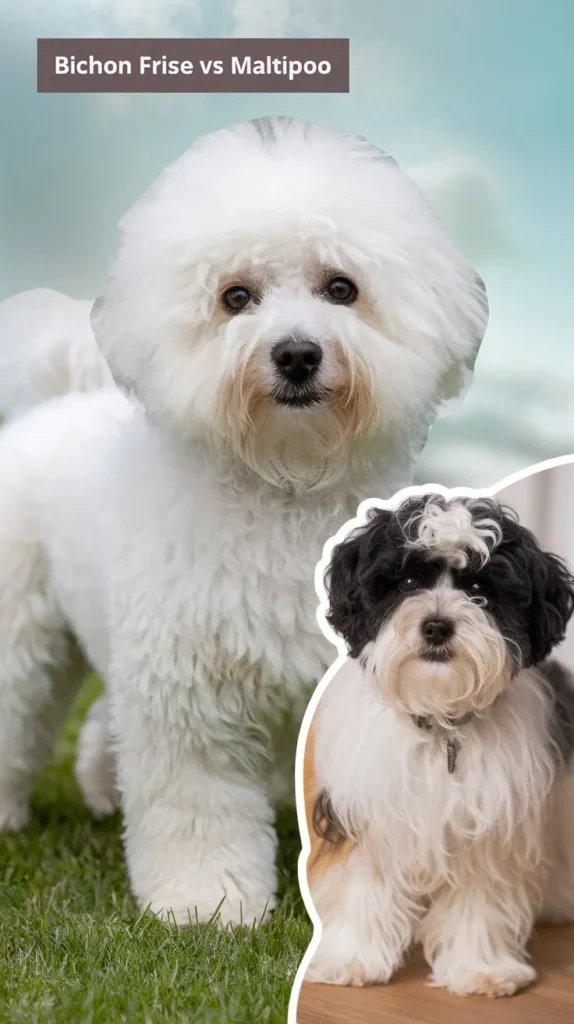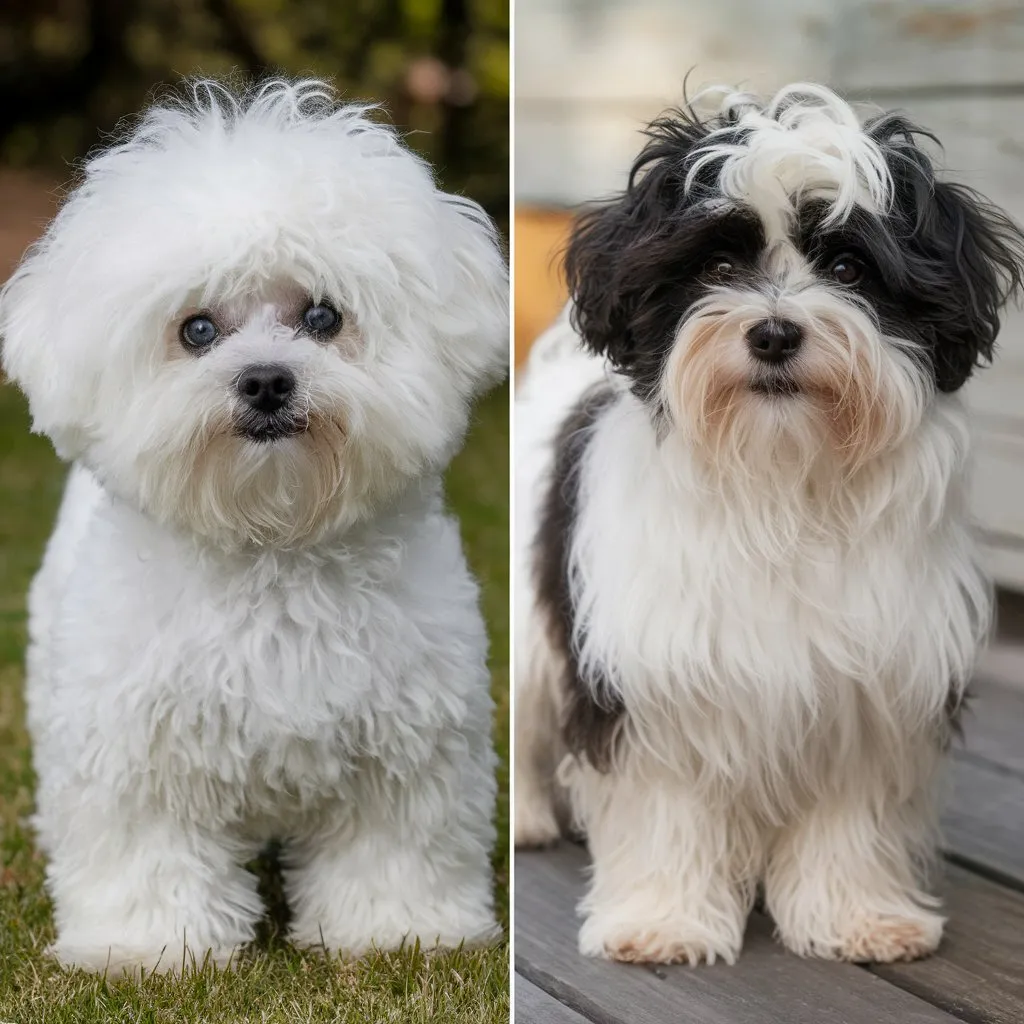Bichon Frise Vs Maltipoo: Which Breed is More Intelligent, Loyal, and Loving?
You’re thinking of bringing a new furry friend into your life, and you’ve narrowed it down to two adorable options: the Bichon Frise and the Maltipoo. Both breeds boast gentle, playful personalities, but that’s where the similarities end.
As you weigh your decision, you’ll want to ponder the unique needs and characteristics of each breed. For instance, do you live in a cozy apartment or have a spacious backyard?
This distinction might just tip the scales in favor of one breed over the other. What else will you discover as you explore the differences between these two beloved breeds?
In a Nutshell

- Bichon Frise and Maltipoo are both small, hypoallergenic breeds suitable for apartment living, but they have distinct origins and histories.
- Bichon Frises have a more uniform height range (9-12 inches) and weight (7-12 pounds), while Maltipoos vary more in height (8-14 inches) and weight (4-8 pounds).
- Both breeds require regular grooming to prevent matting and tangling, but Bichon Frises have a finer, curlier coat, and Maltipoos have a soft, silky coat.
- Bichon Frises are relatively low-maintenance with exercise, needing short, gentle playtime, while Maltipoos require more frequent and varied exercise to prevent boredom.
Breed Origins and History

As you explore into the world of Bichon Frise and Maltipoo, understanding their breed origins and history is crucial.
The Bichon Frise, with its roots dating back to the 13th century, originated in the Mediterranean as a companion dog, while the Maltipoo, a crossbreed between a Maltese and a Poodle, emerged in the 1990s as a deliberate attempt to create a low-shedding, hypoallergenic pet.
You’ll notice that the Bichon Frise boasts an ancient lineage, with its ancestors serving as lap dogs for European royalty.
Over time, the breed evolved through selective breeding, resulting in the fluffy, affectionate companion we’re familiar with today.
In contrast, the Maltipoo’s breed evolution is more recent, with breeders intentionally crossing Maltese and Poodle breeds to create a pet that’s both low-maintenance and allergy-friendly.
Understanding the unique histories of these breeds can help you appreciate their distinct characteristics and needs.
As you continue to explore the world of Bichon Frise and Maltipoo, keep in mind the significance of their breed origins and history in shaping their personalities and traits, which is vital to grasping their individuality.
Size and Weight Comparison

The Bichon Frise typically ranges from 9 to 12 inches in height and weighs between 7 and 12 pounds, while the Maltipoo usually stands between 8 and 14 inches tall and tips the scales at 4 to 8 pounds.
When it comes to puppy proportions, both breeds are deemed small, but the Maltipoo tends to be slightly more petite.
Some key points to ponder when comparing the size and weight of these breeds:
Bichon Frises have a more uniform height range, while Maltipoos can vary more with regard to height.
Maltipoos tend to have more weight fluctuations, possibly due to their hybrid nature.
Both breeds are suitable for apartment living due to their small size.
Their compact size makes them easy to transport and travel with.
Despite their small stature, both breeds are energetic and require regular exercise to stay healthy.
Keep in mind that these are general size and weight ranges, and individual dogs may vary depending on their lineage, diet, and overall health.
Coat Types and Grooming Needs

Grooming is an essential aspect of dog care, and understanding the coat types and needs of Bichon Frises and Maltipoos will help you provide the necessary attention to keep your pet clean, comfortable, and looking its best.
When it comes to coat types, Bichon Frises have a soft, curly, and hypoallergenic fur that requires regular grooming to prevent matting. Their fur texture is fine and silky, with a curl pattern that can range from tight, compact curls to loose, flowing waves.
On the other hand, Maltipoos have a soft, silky, and curly coat that’s often a combination of their Maltese and Poodle parents’ characteristics. Their fur texture is fine and smooth, with a curl pattern that can range from tight, spiral curls to loose, wavy locks.
Both breeds require regular brushing, trimming, and clipping to maintain their coat’s health and appearance. By understanding their unique coat types and needs, you’ll be able to provide the necessary care to keep your Bichon Frise or Maltipoo looking and feeling its best.
Energy Levels and Exercise Needs

Understanding your dog’s energy levels and exercise needs is essential to ensuring they receive the physical and mental stimulation necessary to thrive, and both Bichon Frises and Maltipoos have unique requirements in this area.
As a dog owner, you’ll want to tailor your daily routines to meet their specific needs.
Some key differences exist:
Bichon Frises are relatively low-maintenance with regard to exercise, requiring short, gentle playtime sessions and daily walks of about 15-20 minutes.
Maltipoos, on the other hand, need more frequent and varied exercise to prevent boredom and destructive behavior.
Both breeds benefit from playtime that incorporates mental stimulation, such as puzzle toys and interactive games.
Bichon Frises are more suited to apartment living due to their low energy levels, while Maltipoos require more space to move around.
Regardless of breed, incorporating playtime preferences into your daily routine is pivotal to building a strong bond with your dog and ensuring their overall well-being.
Training and Intelligence Levels

As you tailor your daily routines to meet your dog’s specific needs, it’s also important to ponder their trainability and intelligence levels, which can substantially impact the effectiveness of your training approach and overall relationship with your pet.
Both Bichon Frises and Maltipoos are intelligent breeds, but they’ve different learning styles and aptitudes.
Bichon Frises are known for being highly trainable, responding well to positive reinforcement and reward-based training strategies. They’re quick to pick up commands and can excel in obedience training.
Maltipoos, on the other hand, can be more challenging to train due to their independent nature. Consistency, patience, and positive reinforcement are key when training a Maltipoo.
When it comes to housebreaking challenges, both breeds can be stubborn at times.
However, with a consistent routine, positive reinforcement, and plenty of praise, you can overcome these obstacles. Crucial to establishing clear boundaries and being patient with your dog as they learn.
Temperament and Socialization

Your Bichon Frise or Maltipoo’s temperament and socialization play a pivotal role in shaping their behavior, influencing how they interact with you, other pets, and strangers. As you raise your furry friend, you’ll notice their unique personality traits emerging. Both breeds are known for their playful and gentle nature, making them excellent companions.
Social skills development: Bichon Frises and Maltipoos thrive on human interaction, so it’s essential to provide them with plenty of opportunities to socialize with people and other animals.
Playful personality traits: Both breeds are playful and love to have fun, which makes them perfect for families with children or for owners who enjoy active playtime.
Affectionate nature: Your Bichon Frise or Maltipoo will likely become your shadow, as they adore human company and attention.
Adaptability: Both breeds are relatively easy to adapt to new environments and living situations, making them a great choice for city dwellers or those who enjoy traveling.
Training responsiveness: With positive reinforcement and consistent training, your Bichon Frise or Maltipoo will quickly learn to respond to commands and behave well in public.
Health Issues and Life Expectancy

When it comes to health issues, both Bichon Frises and Maltipoos are prone to certain medical conditions that can impact their quality of life and lifespan.
As a potential owner, you should be aware of these potential health concerns to provide the best possible care for your pet.
Eye problems are common in both breeds, with cataracts, progressive retinal atrophy, and eyelid problems being frequent occurrences.
Regular eye check-ups are vital to detect any issues early on.
You should also keep an eye out for signs of Heart conditions, such as patent ductus arteriosus, which can lead to heart failure if left untreated.
On average, Bichon Frises live for 12-15 years, while Maltipoos typically live for 10-13 years.
However, with proper care and attention to health issues, some individuals have been known to live up to 18 years or more.
By being proactive about your pet’s health, you can help guarantee they live a long, happy, and healthy life.
Regular veterinary check-ups, a balanced diet, and a safe living environment are all pivotal in preventing and managing health issues.
Noise Levels and Barking Tendencies

Both Bichon Frises and Maltipoos are considered moderate barkers, with a tendency to alert you to potential threats or stimuli, such as strangers, noises, or movements.
As you consider bringing one of these breeds into your life, crucial understanding of their barking tendencies and noise tolerance is vital.
Bark frequency: Both breeds tend to bark moderately, with an average of 2-3 barks per stimulus. However, they can be trained to reduce barking with consistent reinforcement.
Noise tolerance: Bichon Frises are more sensitive to noise, while Maltipoos are more adaptable. If you live in a noisy area, a Maltipoo might be a better fit.
Triggered barking: Both breeds tend to bark at strangers, noises, and movements. However, they can be socialized to reduce barking at strangers.
Attention-seeking barking: Both breeds are prone to attention-seeking barking. Ignore the barking, and reward quiet behavior to minimize this habit.
Training: Consistent training and socialization can markedly reduce barking in both breeds.
Family Suitability and Child Friendliness

As you ponder bringing a Bichon Frise or Maltipoo into your household, it’s crucial to assess their suitability for families with children, given their unique temperaments and needs. Both breeds can flourish in families with kids, but there are some key differences to ponder.
| Breed | Energy Level | Tolerance for Children | Training Ease |
|---|---|---|---|
| Bichon Frise | Low-Moderate | High | High |
| Maltipoo | Moderate-High | Moderate-High | Moderate |
| Both | Gentle | Adaptable | Socialization Key |
| Both | Playful | Patient | Consistent Boundaries |
| Both | Loyal | Protective | Positive Reinforcement |
The Bichon Frise is generally more laid-back and easier to train, making them a great fit for families with younger children. Maltipoos, on the other hand, have higher energy levels and require more exercise and stimulation.
However, both breeds are gentle, playful, and adaptable, making them suitable for families with children of all ages. To guarantee sibling harmony, it’s imperative to socialize your pet well and establish clear boundaries and rules for interaction.
With patience, consistency, and positive reinforcement, either breed can become a loving and integral part of your family dynamics.
Pet-Friendliness and Adaptability

You’ll want to ponder how well a Bichon Frise or Maltipoo will fit in with your existing pets, given their unique personalities and adaptability requirements. Both breeds are known for their gentle nature, but they do have some differences when it comes to pet-friendliness and adaptability.
Some key factors to weigh:
Urban adaptability: Bichon Frises are well-suited for city living due to their quiet nature and minimal exercise needs. Maltipoos are also adaptable to urban environments, but they do require more exercise and socialization.
Family dynamics: Both breeds thrive on human interaction and attention. However, Bichon Frises can be more demanding of attention, while Maltipoos are often more laid-back.
Energy levels: Maltipoos tend to be more energetic than Bichon Frises, requiring more exercise and playtime.
Noise tolerance: Bichon Frises are more sensitive to noise, while Maltipoos are generally more tolerant.
Training needs: Both breeds require early socialization and training, but Maltipoos can be more stubborn at times.
Ultimately, the decision between a Bichon Frise and a Maltipoo comes down to your lifestyle, living situation, and personal preferences.
Grooming Requirements and Costs

Your new pet’s grooming needs will substantially impact your daily routine and budget, so it’s vital to understand the differences in grooming requirements and costs between Bichon Frises and Maltipoos.
Both breeds require regular grooming to prevent matting and tangling of their fur. However, Bichon Frises need more frequent grooming sessions, ideally daily, to prevent grooming mistakes that can lead to skin irritation.
Maltipoos, on the other hand, can get by with weekly grooming sessions. This difference in grooming frequency will impact your daily routine and budget.
In terms of costs, you can expect to pay around $60 to $90 per session for a professional groomer, with Bichon Frises requiring more frequent sessions.
Additionally, you’ll need to invest in pet pampering tools like brushes, clippers, and shampoos. While it may seem like a significant investment, proper grooming is essential for your pet’s health and well-being.
Feeding and Nutrition Needs

When it comes to feeding your Bichon Frise or Maltipoo, you’ll want to ponder their unique needs to guarantee they’re getting the nutrients they require.
You’ll need to determine their daily caloric intake, taking into account factors like age, size, and activity level.
Additionally, you’ll want to be aware of any dietary restrictions and choose nutrient-rich food options that cater to their specific requirements.
Daily Caloric Intake
Both Bichon Frises and Maltipoos require a specific daily caloric intake to maintain ideal health, with puppies needing more calories per pound of body weight than adults.
As a responsible pet owner, it’s vital you grasp their unique needs to provide the right amount of nutrition.
When it comes to feeding your Bichon Frise or Maltipoo, you’ll want to ponder the following:
Puppy portions: Puppies need more calories per pound than adults, so divide their daily ration into 3-4 meals until they’re about six months old.
Meal frequency: Adult dogs can thrive on two meals a day, but puppies may require more frequent feeding.
Weight management: Monitor your dog’s weight and adjust their caloric intake accordingly to prevent obesity.
Activity level: Dogs with higher activity levels require more calories to maintain their energy levels.
Age and health: As your dog ages or develops health issues, their caloric needs may change; consult with your veterinarian to determine the best course of action.
Dietary Restrictions Matter
Bichon Frises and Maltipoos require diets tailored to their specific nutritional needs, which can be influenced by factors such as food sensitivities, allergies, and life stages.
You’ll need to take into account these factors to guarantee your pet flourishes. Food allergies, for instance, can cause skin issues, digestive problems, and ear infections.
Common allergens include beef, dairy, and wheat. If you suspect your pet has a food allergy, consult with your vet to determine the best course of action.
You may need to implement special diets to accommodate your pet’s needs. For example, a hypoallergenic diet can help alleviate allergy symptoms.
You may also need to avoid certain ingredients, such as fillers or by-products, that can exacerbate food sensitivities. Additionally, puppies, adult dogs, and seniors have different nutritional requirements, so you’ll need to adjust their diets accordingly.
Nutrient-Rich Food Options
Selecting nutrient-rich food options that cater to your pet’s specific needs is essential, as a well-balanced diet directly impacts their overall health and longevity.
As a responsible pet owner, you want to guarantee your Bichon Frise or Maltipoo receives the necessary nutrients to thrive.
When choosing a food option, consider the following key factors:
High-quality protein sources: Look for named protein sources like chicken, salmon, or lamb to support muscle growth and maintenance.
Whole grains and fiber: Whole grains like brown rice, oats, and barley provide sustained energy, while fiber supports digestive health.
Essential vitamins and minerals: Vitamins A, D, and E, as well as minerals like calcium and phosphorus, are pivotal for immune system function and overall health.
Healthy fats: Omega-3 fatty acids from sources like fish oil support skin and coat health, as well as brain function.
Limited ingredient diets: Consider diets with fewer ingredients to reduce the risk of food sensitivities and allergies.
Space and Living Situation Needs

When considering a Bichon Frise or Maltipoo as a pet, you’ll need to assess your living situation to verify it’s suitable for either breed.
Apartment living can be a challenge for these dogs, but it’s not impossible – you’ll just need to make some adjustments.
You must comprehend the specific space and outdoor requirements of each breed to determine which one is the best fit for your lifestyle.
Apartment Living Constraints
Your living situation and available space play a significant role in determining whether a Bichon Frise or Maltipoo is the better fit for you.
If you’re an urban dweller living in a small apartment, you’ll want to weigh the space constraints of each breed.
When it comes to apartment living, some key factors to ponder:
Space: Both breeds are adaptable to small spaces, but Maltipoos tend to be more energetic and may require more room to move around.
Noise level: Bichon Frises are generally quieter than Maltipoos, which can be beneficial for apartment dwellers with noise restrictions.
Exercise needs: While both breeds need regular exercise, Maltipoos require more frequent and longer walks to keep them happy and healthy.
Grooming: Both breeds require regular grooming, but Bichon Frises need more frequent bathing and trimming due to their curly coats.
Training: Maltipoos can be more challenging to train due to their stubbornness, but consistent training and positive reinforcement can help.
Outdoor Space Requirements
Having a yard or access to outdoor spaces substantially impacts the quality of life for both Bichon Frises and Maltipoos, as they require varying levels of outdoor activity and exercise to thrive. As you consider bringing one of these breeds into your life, it’s crucial to evaluate your outdoor space and living situation.
| Breed | Outdoor Space Requirements |
|---|---|
| Bichon Frise | Daily short walks (10-15 minutes), occasional playtime in a securely fenced area |
| Maltipoo | Daily short walks (10-15 minutes), occasional playtime in a securely fenced area, adaptable to apartment living with regular outdoor breaks |
| Both | Access to a patio or balcony for supervised outdoor time, regular potty breaks |
| Both | Regular grooming to prevent matting and tangling from outdoor debris |
| Both | Backyard necessities: shade, water, and protection from extreme temperatures |
When evaluating your outdoor space, consider your patio preferences and whether they align with your breed of choice. Remember, both Bichon Frises and Maltipoos require regular outdoor activity to stay happy and healthy.
Noise Sensitivity and Anxiety

Both Bichon Frises and Maltipoos can exhibit varying degrees of noise sensitivity and anxiety, which may manifest as destructive behavior, excessive barking, or even fear-based aggression.
As a responsible owner, recognizing the signs and taking proactive steps to mitigate these issues is crucial. You may notice that your pet becomes agitated or fearful during loud events, such as fireworks or thunderstorms, which can trigger sound phobias.
To help your pet cope with noise sensitivity and anxiety, consider the following calming strategies:
- Desensitize your pet to loud noises by gradually exposing them to recorded sounds at increasing volumes.
- Create a safe space or ‘den’ where your pet can retreat during stressful events.
- Use calming aids like pheromone diffusers, calming treats, or anxiety wraps.
- Engage your pet in calming activities, such as gentle exercise or play, before a potentially stressful event.
Cost and Maintenance Comparison

When considering bringing a Bichon Frise or Maltipoo into your life, you’ll want to factor in the costs associated with caring for these breeds.
You’ll need to budget for daily care expenses, such as food, grooming, and veterinary care, which can add up quickly.
Daily Care Expenses
You’ll need to budget around $50 to $70 per month for daily care expenses for a Bichon Frise, while a Maltipoo’s monthly expenses will range from $40 to $60, depending on several factors. These costs cover essential expenses that guarantee your pet’s health and well-being.
Pet insurance can cost around $20 to $50 per month, depending on the provider and coverage.
Veterinary visits can cost around $20 to $50 per visit, covering regular check-ups and vaccinations.
Food and treats can cost around $20 to $30 per month, including high-quality dog food and healthy treats.
Grooming can cost around $30 to $90 per session, covering regular brushing, nail trimming, and baths.
Toys and accessories can cost around $10 to $20 per month, including chew toys, leashes, and collars.
Keep in mind that these expenses can vary depending on your pet’s age, size, and health conditions. By budgeting for these daily care expenses, you can guarantee your Bichon Frise or Maltipoo receives the care they need to thrive.
Lifetime Cost Estimate

Estimating the lifetime cost of a Bichon Frise or Maltipoo helps you prepare for the long-term financial commitment of dog ownership, which can range from $15,000 to $30,000 or more over 12 to 15 years, depending on factors like food quality, veterinary care, and grooming needs.
Here’s a breakdown of the estimated costs:
| Category | Bichon Frise | Maltipoo |
|---|---|---|
| Initial Investment | $1,000 – $2,000 | $1,000 – $2,000 |
| Ongoing Expenses (Yearly) | $1,500 – $2,500 | $1,500 – $2,500 |
| Grooming Needs (Yearly) | $600 – $1,200 | $600 – $1,200 |
| Veterinary Care (Yearly) | $500 – $1,000 | $500 – $1,000 |
You’ll notice that both breeds have similar cost estimates. The initial investment includes the purchase or adoption fee, spaying/neutering, and initial vaccinations.
Ongoing expenses cover food, toys, and training. Grooming needs are higher for both breeds due to their high-maintenance coats. Veterinary care costs vary depending on your dog’s health and age. By understanding these costs, you can better plan for your new furry friend’s arrival.
Frequently Asked Questions
Can Bichon Frises and Maltipoos Be Left Alone During Work Hours?
You can’t leave small breeds alone for extended periods, as they’re prone to lonely anxiety and separation distress, but with training, exercise, and mental stimulation, you can reduce their stress and enjoy your freedom.
Do These Breeds Require a Specific Type of Living Environment?
When choosing a pet, you’ll want to weigh their living environment needs. Generally, small breeds thrive in urban dwellings or quiet neighborhoods with minimal noise and distractions, allowing them to feel secure and relaxed in their space.
How Often Should I Bathe My Bichon Frise or Maltipoo?
You should bathe your dog every 2-3 weeks, but more frequently during shedding seasons or if they develop skin allergies. Over-bathing can strip their coat of natural oils, so find a balance that suits their individual needs.
Can I Have a Bichon Frise or Maltipoo in an Apartment With Thin Walls?
You can have a dog in an apartment with thin walls, but be prepared to mitigate apartment noise. Train your dog to minimize barking, and consider soundproofing to avoid neighbor complaints.
Are Bichon Frises and Maltipoos Prone to Escaping or Running Away?
You’ll want to guarantee fence security and maintain yard supervision, as small breeds can be prone to escaping or running away if they catch a whiff of freedom or spot an open gate.

Hi, I’m Ella Frost, a devoted animal lover working at CuddlyCreatureCare.com. My passion for animals drives me to share my knowledge through comprehensive guides on animal care and rescue. I’m here to help you understand and care for your furry friends better.







